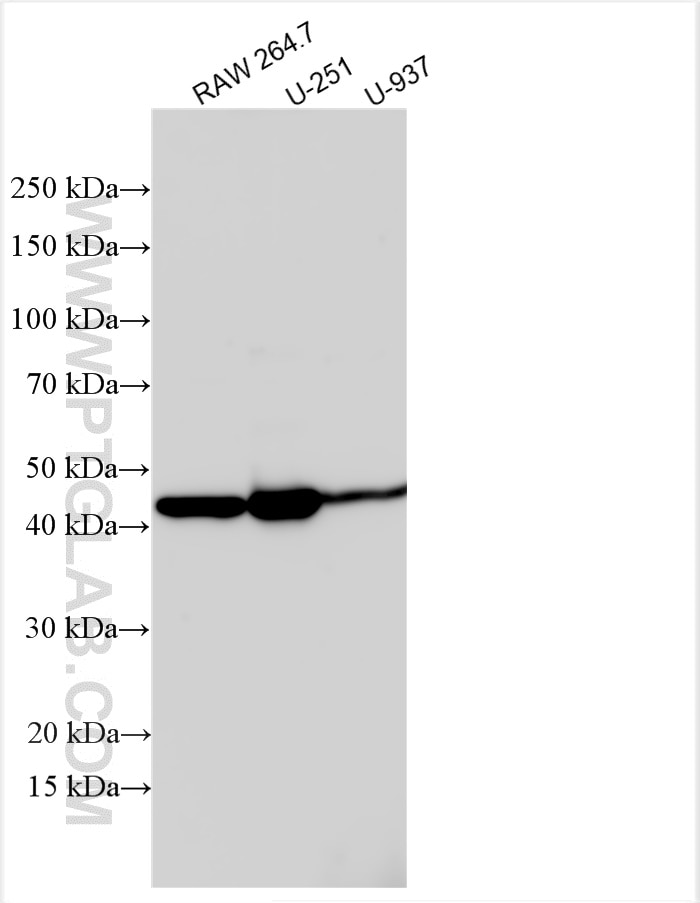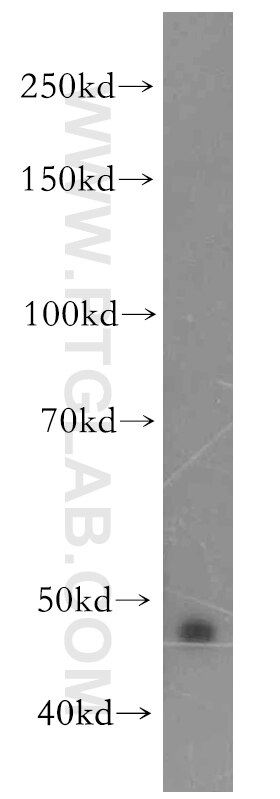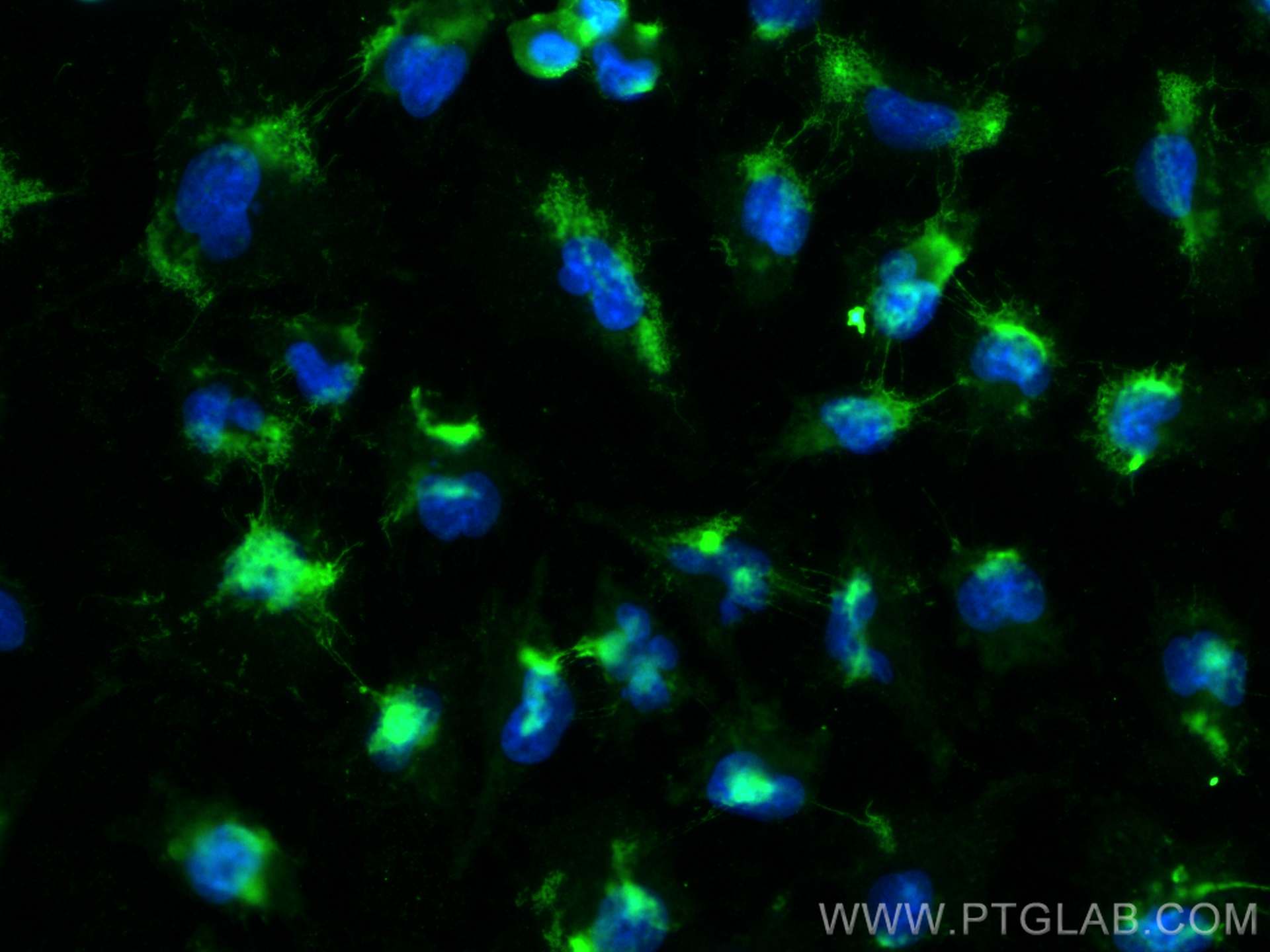Validation Data Gallery
Tested Applications
| Positive WB detected in | RAW 264.7 cells, A2780 cells, U-251 cells, U-937 cells |
| Positive IF/ICC detected in | U-251 cells |
Recommended dilution
| Application | Dilution |
|---|---|
| Western Blot (WB) | WB : 1:1000-1:8000 |
| Immunofluorescence (IF)/ICC | IF/ICC : 1:200-1:800 |
| It is recommended that this reagent should be titrated in each testing system to obtain optimal results. | |
| Sample-dependent, Check data in validation data gallery. | |
Published Applications
| KD/KO | See 1 publications below |
| WB | See 16 publications below |
| IHC | See 8 publications below |
| IF | See 5 publications below |
| CoIP | See 1 publications below |
Product Information
10286-1-AP targets uPAR/CD87 in WB, IHC, IF/ICC, CoIP, ELISA applications and shows reactivity with human, mouse samples.
| Tested Reactivity | human, mouse |
| Cited Reactivity | human, mouse, bovine |
| Host / Isotype | Rabbit / IgG |
| Class | Polyclonal |
| Type | Antibody |
| Immunogen |
CatNo: Ag0187 Product name: Recombinant human uPAR, PLAUR protein Source: e coli.-derived, PGEX-4T Tag: GST Domain: 1-136 aa of BC002788 Sequence: MGHPPLLPLLLLLHTCVPASWGLRCMQCKTNGDCRVEECALGQDLCRTTIVRLWEEGEELELVEKSCTHSEKTNRTLSYRTGLKITSLTEVVCGLDLCNQGNSGRAVTYSRSRYLECISCGSSDMSCERGRHQSLQ 相同性解析による交差性が予測される生物種 |
| Full Name | PLAUR |
| Calculated molecular weight | 37 kDa |
| Observed molecular weight | 35-50 kDa |
| GenBank accession number | BC002788 |
| Gene Symbol | uPAR |
| Gene ID (NCBI) | 5329 |
| RRID | AB_10667460 |
| Conjugate | Unconjugated |
| Form | |
| Form | Liquid |
| Purification Method | Antigen affinity purification |
| UNIPROT ID | Q03405 |
| Storage Buffer | PBS with 0.02% sodium azide and 50% glycerol{{ptg:BufferTemp}}7.3 |
| Storage Conditions | Store at -20°C. Stable for one year after shipment. Aliquoting is unnecessary for -20oC storage. |
Background Information
uPAR is a 45-65 kDa, highly glycosylated, GPI-anchored membrane protein. In addition to the membrane-anchored form, uPAR is released from the plasma membrane by cleavage of the GPI anchor and can be found as a soluble form (suPAR). uPAR contains three homologous domains (D1-D3) of which the N-terminal one (D1) represents the uPA-binding domain. After binding to uPAR, uPA cleaves plasminogen, generating the active protease plasmin which is involved in a wide variety of physiologic and pathologic processes. In addition to regulating proteolysis, uPAR has important function in cell adhesion, migration and proliferation. Studies reveal that uPAR expression is elevated during inflammation and tissue remodelling and in many human cancers, in which it frequently indicates poor prognosis. (PMID 20027185; 12461559)
Protocols
| Product Specific Protocols | |
|---|---|
| IF protocol for uPAR/CD87 antibody 10286-1-AP | Download protocol |
| WB protocol for uPAR/CD87 antibody 10286-1-AP | Download protocol |
| Standard Protocols | |
|---|---|
| Click here to view our Standard Protocols |
Publications
| Species | Application | Title |
|---|---|---|
Mol Cell A transient transcriptional activation governs unpolarized-to-polarized morphogenesis during embryo implantation | ||
Nat Commun Sirt6 deficiency exacerbates podocyte injury and proteinuria through targeting Notch signaling. | ||
J Hazard Mater Epigenetic reprogramming of HDAC2 in CA1 excitatory neurons determines Pb-induced non-spatial memory deficits | ||
Cancer Res Bcl-xL enforces a slow-cycling state necessary for survival in the nutrient-deprived microenvironment of pancreatic cancer. | ||
Nucleic Acids Res Regulation of u-PAR gene expression by H2A.Z is modulated by the MEK-ERK/AP-1 pathway. | ||
Mech Ageing Dev Induction of epithelial cell senescence by SERPINE1 derived from fibroblasts in the amnion at parturition |



